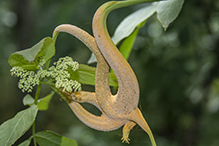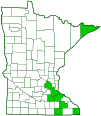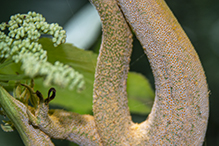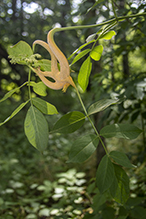Elderberry Rust
(Puccinia bolleyana)
Conservation • Description • Habitat • Ecology • Distribution • Taxonomy
Conservation Status |
|
|||||||
| IUCN Red List | not listed |
|||||||
| NatureServe | not listed |
|||||||
| Minnesota | not listed |
|||||||
Description |
||
Elderberry Rust is a fungus that affects American elderberry and at least twelve species of sedge. It occurs in eastern United States east of the Great Plains and in Ontario. There are only six recorded sightings of this rust in Minnesota. All of them are dated prior to 1940 and are in Cook, Goodhue, and Houston Counties. However, rusts on plants are often overlooked and seldom reported. The scarcity of records for Elderberry Rust may not reflect its actual abundance. Elderberry Rust first appears in early spring as small, bright orange pustules on the leaflets and petioles of American elderberry. In May it develops large bright orange pustules that causes deformation of the plant’s leaves, petioles, and stems. In the summer, spores are wind-blown to the alternate hosts, twelve species of sedges: Frank's sedge (C. frankii), Bebb's sedge (C. bebbii), button sedge (C. bullata), longhair or bottlebrush sedge (C. comosa), fringed sedge (C. crinita), raven or crow-foot sedge (C. crus-corvi), greater bladder sedge (C. intumescens), false hop sedge (C. lupuliformis), hop sedge (C. lupulina), shallow or lurid sedge (C. lurida), blunt broom sedge (C. tribuloides), and hairy fruited sedge (C. trichocarpa). Infection on the sedge plant appears as necrotic lesions on the leaves. |
||
Similar Species |
||
Habitat and Hosts |
||
American elderberry and sedges |
||
Ecology |
||
Season |
||
Early spring to fall |
||
Distribution |
||||
|
Sources |
|||
| 2/1/2023 | ||||
Occurrence |
||||
Unknown |
||||
Taxonomy |
|||
| Kingdom | Fungi (fungi) | ||
| Subkingdom | Dikarya | ||
| Phylum | Basidiomycota (club fungi) | ||
| Subphylum | Pucciniomycotina | ||
| Class | Pucciniomycetes | ||
| Order | Pucciniales (rust fungi) | ||
| Suborder | Uredinineae | ||
| Family | Pucciniaceae | ||
| Genus | Puccinia (orange-yellow rusts) | ||
Elderberry Rust was published as Aecidium sambuci in 1822, as Puccinia bolleyana in 1891, and as Puccinia sambuci in 1903. The latter two names are both widely in use. |
|||
Synonyms |
|||
Aecidium sambuci Dicaeoma bolleyanum Puccinia atkinsoniana var. bolleyana Puccinia sambuci |
|||
Common Names |
|||
| Elderberry Rust | |||

Slideshows |
||

Visitor Videos |
|||
Share your video of this mammal. |
|||
| This button not working for you? Simply email us at info@MinnesotaSeasons.com. Attach a video, a YouTube link, or a cloud storage link. |
|||
Other Videos |
|||
| Puccinia Life Cycle Pests, Weeds & Problems |
|||
About
May 19, 2018 Puccinia Life Cycle. Puccinia is a genus of fungi that cause a serious plant disease commonly called rust; the genus contains thousands of species, and the various species infect a wide range of host plants. The life cycle of the fungi is complex, typically involving five kinds of spores and two unrelated types of host plants. Because Puccinia... Table of contents Puccinia Life Cycle |
|||

Visitor Sightings |
|||||
Report a sighting of this fungus. |
|||||
| This button not working for you? Simply email us at info@MinnesotaSeasons.com. Be sure to include a location. |
|||||
| Nate 7/4/2025 |
Location: 5 miles South of Preston, MN |
||||
| Lindsey 7/5/2021 |
Location: Gamehaven Reserve, Rochester, MN multiple sightings there (at least 3-4) |
||||
| Amber Fiedler 7/1/2021 |
Location: 31 Ave SW, Rochester MN 55902 It started last fall and is destroying my 4 bushes this summer. |
||||
MinnesotaSeasons.com Sightings |
|||||

Created: 11/29/2019
Last Updated:



